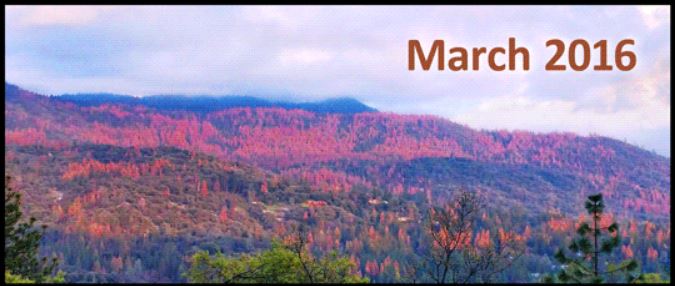
Tree Mortality in the Sierra Nevada
http://www.sierranevada.ca.gov/our-region/tree-mortality/tree-mortality
THE PROBLEM
California is experiencing tree die-off at an unprecedented scale, and the Sierra Nevada Region has been hit extremely hard. 129 million trees have died across the state due to drought and bark beetles since 2010, and 85 percent of those dead trees are in the Sierra.
Madera-mortality_2015-16_540x231.gif
Location in Madera County before and after tree mortality began spreading. Photos: Margarita Gordus, CA Department of Fish and Wildlife
Sierra Nevada forests and watersheds are at a critical point. Ongoing drought, a century of fire suppression, widespread tree mortality due to insect attacks and disease, and a changing climate have led to incredible changes across the Sierra Nevada Region. Even though California received record-breaking rains during the winter of 2016-2017, the effects of five consecutive years of drought, an increase in the bark beetle population, and warming temperatures have led to continued die-off. The map below shows the changes in tree mortality between 2006 and 2017. The southern Sierra was decimated by tree mortality in 2015 and 2016. Now the die-off continues to move north and to higher elevations.
TreeMortality
THE IMPACTS
Millions of dead trees can fuel larger, more damaging wildfires which can have long-term impacts on our water, air, wildlife, recreation, and climate.
WHAT IS BEING DONE?
TMTFlogo_105x105.pngCalifornia’s Tree Mortality Task Force (TMTF) is working to address immediate public health and safety risks by removing dead trees from roads, transmission lines, public recreation sites, and communities. The Sierra Nevada Conservancy is a member of the Tree Mortality Task Force and is working closely with other state, local, and federal agencies, utilities, industry representatives, and environmental stakeholders to look for long-term solutions that support healthy forests and communities.
Collectively, the TMTF has removed over one million dead trees in areas where public safety was at highest risk, but with a staggering 129 million dead trees, the work of the task force is far from over.
WHAT ELSE CAN BE DONE?
smallFires-strongerForests_325x173.gif
Overgrown forests are more susceptible to insect attack and drought because there are too many trees competing for limited water and nutrients. Reducing competition by doing more restoration, such as ecologically-sound thinning and using prescribed or managed fire, can help protect our still-green forests from future drought, insects, and disease.
The Sierra Nevada Watershed Improvement Program – a partnership between the Sierra Nevada Conservancy and the U.S. Forest Service – is working to increase the pace and scale of restoration across the Sierra Nevada Region by increasing funding, addressing policy impediments, and increasing infrastructure needed to support restoration.
Treated-vs-Untreated-LilyGap_540x180.jpg
Photos take at the Lily Gap Project in Calaveras County showing the difference in forest health between a thinned forest and an unthinned forest.
ADDITIONAL RESOURCES
Tree Mortality Fact Sheet
Tree Mortality Map Viewer
U.S. Forest Service Tree Mortality Page
CAL FIRE’s Public Outreach Page
